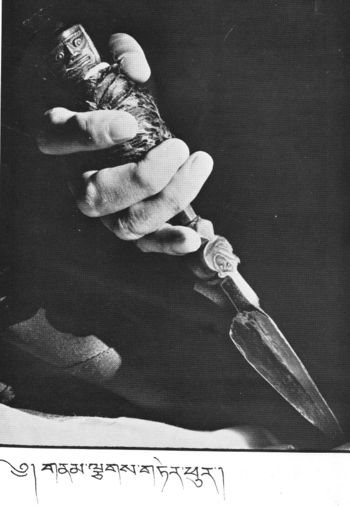Phurba: Difference between revisions
Jump to navigation
Jump to search
(New page: '''Phurba''' (Skt. ''kila'') - a ritual dagger, such as that held by the deity Vajrakilaya. ==Four Phurbas== According to the tradition of Vajrakilaya, there are four phurbas: #''Ky...) |
|||
| (10 intermediate revisions by 3 users not shown) | |||
| Line 1: | Line 1: | ||
'''Phurba''' (Skt. '' | [[Image:Lama Gonpo Phurba.jpg|thumb|350px|The '''Namchak Ter Phurba''' discovered by [[Nyang Ral Nyima Özer]], which belonged to [[Gönpo Tseten Rinpoche]]]] | ||
'''Phurba''' (Tib. [[ཕུར་པ་]], [[Wyl.]] ''phur pa''/''phur bu''; Skt. ''kīla''/''kīlaya'') — a ritual dagger with a pointed three-edge blade, such as that held by the deity [[Vajrakilaya]]. | |||
== | ==Subdivisions== | ||
According to the tradition of Vajrakilaya, there are '''four phurbas'''. | |||
One way to enumerate them is:<ref>Source: oral teaching by [[Dilgo Khyentse Rinpoche]] in [[Prapoutel]]; Khyentse Rinpoche is said to have based this list on a quote from [[Jamyang Khyentse Wangpo]].</ref> | |||
#the [[kyérim]], or generative phase, of the phurba of existence (Tib. བསྐྱེད་རིམ་སྲིད་པའི་ཕུར་པ་, ''kyérim sipé phurba'') | |||
#the actual material phurba (Tib. མཚན་མ་རྫས་ཀྱི་ཕུར་པ་, ''tsenma dzé kyi phurba'') | |||
#the [[dzogrim]], or dissolution phase, of the phurba of [[bodhichitta]] (Tib. རྫོགས་རིམ་བྱང་སེམས་ཕུར་པ་, ''dzogrim changsem phurba'') | |||
#the [[absolute]] phurba of [[rigpa]] (Tib. རིག་པ་དོན་གྱི་ཕུར་པ་, ''rigpa dön gyi phurba'') | |||
#'' | Alternatively<ref>[[Khenpo Namdrol]] (1999), page 45.</ref>: | ||
#the wisdom awareness phurba (Wyl. ''rig pa ye shes kyi phur pa'') | |||
#'' | #the enlightened mind phurba (Wyl. ''byang chub sems kyi phur pa'') | ||
#the immeasurable compassion phurba (Wyl. ''tshad med snying rje’i phur pa'') | |||
#the substantial phurba (Wyl. ''‘dus byas rdzas kyi phur pa'' or ''mtshan ma rdzas kyi phur pa'') | |||
==References== | |||
<small><references/></small> | |||
[[Category: | ==Teachings given to the [[About Rigpa|Rigpa]] Sangha== | ||
*[[Orgyen Tobgyal Rinpoche]], [[Lerab Ling]], 13-14 August 2018 | |||
==Further Reading== | |||
*[[Khenpo Namdrol]], ''Vajrakilaya'' (Dharmakosha, 1997 or Snow Lion: 1999), pages 45-48. | |||
[[Category:Vajrayana]] | |||
[[Category:Vajrakilaya]] | |||
[[Category:Hand Implements]] | |||
Latest revision as of 09:15, 14 August 2018

Phurba (Tib. ཕུར་པ་, Wyl. phur pa/phur bu; Skt. kīla/kīlaya) — a ritual dagger with a pointed three-edge blade, such as that held by the deity Vajrakilaya.
Subdivisions
According to the tradition of Vajrakilaya, there are four phurbas.
One way to enumerate them is:[1]
- the kyérim, or generative phase, of the phurba of existence (Tib. བསྐྱེད་རིམ་སྲིད་པའི་ཕུར་པ་, kyérim sipé phurba)
- the actual material phurba (Tib. མཚན་མ་རྫས་ཀྱི་ཕུར་པ་, tsenma dzé kyi phurba)
- the dzogrim, or dissolution phase, of the phurba of bodhichitta (Tib. རྫོགས་རིམ་བྱང་སེམས་ཕུར་པ་, dzogrim changsem phurba)
- the absolute phurba of rigpa (Tib. རིག་པ་དོན་གྱི་ཕུར་པ་, rigpa dön gyi phurba)
Alternatively[2]:
- the wisdom awareness phurba (Wyl. rig pa ye shes kyi phur pa)
- the enlightened mind phurba (Wyl. byang chub sems kyi phur pa)
- the immeasurable compassion phurba (Wyl. tshad med snying rje’i phur pa)
- the substantial phurba (Wyl. ‘dus byas rdzas kyi phur pa or mtshan ma rdzas kyi phur pa)
References
- ↑ Source: oral teaching by Dilgo Khyentse Rinpoche in Prapoutel; Khyentse Rinpoche is said to have based this list on a quote from Jamyang Khyentse Wangpo.
- ↑ Khenpo Namdrol (1999), page 45.
Teachings given to the Rigpa Sangha
- Orgyen Tobgyal Rinpoche, Lerab Ling, 13-14 August 2018
Further Reading
- Khenpo Namdrol, Vajrakilaya (Dharmakosha, 1997 or Snow Lion: 1999), pages 45-48.